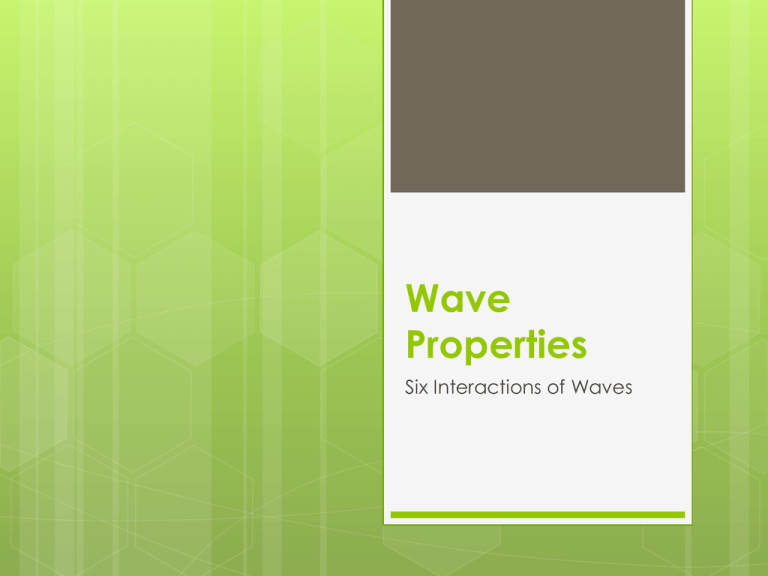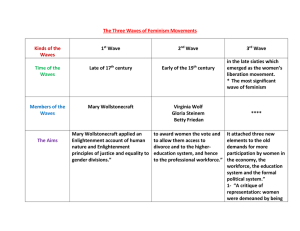Wave Interference
advertisement

Wave Properties Six Interactions of Waves Wave Properties There are 6 main properties, or interactions, of waves that occur when a wave comes in contact with another wave , or a boundary. The 6 Interactions of waves are Interference Diffraction Reflection Refraction Absorption Polarization Interference When two or more waves combine together. Superposition principle There are typically many waves in the same system at the same time. When more than one wave is present, the total oscillation of any point is the sum of the oscillations from each individual wave. The sound waves and light waves you experience are the superposition (adding up) of thousands of waves with different frequencies and amplitudes. Your eyes, ears, and brain separate the waves in order to recognize individual sounds and colors. Constructive Interference Constructive interference occurs when waves add up to create a larger amplitude wave. These waves are in-phase with each other. Constructive Interference When two waves combine to make a larger wave. (crest & crest) or (trough & trough) Destructive Interference Destructive interference occurs when waves add up to make a smaller amplitude wave. These other. waves are out-of-phase with each Destructive Interference Two or more waves combine to produce a smaller wave or destroy the wave completely. (crest & trough) Check for Understanding! 1. 2. Results of Interference of Waves One of the consequences of wave interference is a phenomenon called resonance. Resonance is the reinforcing of an object’s natural frequency so that the amplitude increases very quickly. Can you think of something that you have seen or heard that you believe to be caused by resonance? Standing Waves A wave that is confined between boundaries is called a standing wave. With all waves, resonance and natural frequency are dependent on reflections from boundaries of the system containing the wave. Resonance occurs when the reflected pulses add together to form a large amplitude pulse. Resonance Resonance can also occur when one object vibrates another without touching A sound wave vibrates a snare drum A singer hits a note that shatters a glass A struck tuning fork causes another tuning fork of the same frequency to vibrate The strings of a guitar vibrate from a sound across the room Resonance Natural Frequency and Resonance The natural frequency is sometimes called the resonant frequency because the frequencies are the same when the large amplitudes begin to occur. Resonance Real World Examples: Chinook Helicopter Ground Resonance Test The Tacoma-Narrows Bridge is an example of driven oscillations that result in large amplitude oscillations. Diffraction The bending of a wave as it moves around an obstacle or passes through a narrow opening. Diffraction When waves pass a barrier they curve around it slightly. When they pass through a small opening, they spread out almost as if they had come from a point source. These effects happen for all types of wave: water; sound; light; seismic waves, etc. Diffraction Diffraction & Bats •Bats hunt by echolocation—bouncing sound waves off of prey and listening for echoes, so they need to emit sound with a wavelength smaller than the typical moth. •Bats use ultrasonic sound waves (high frequency waves humans can’t hear) to hunt moths. •The bats use ultrasound is because at lower frequencies the longer waves would diffract around the moth because they would be close to the same size. •High frequency sound waves reflect off the moths rather than diffracting around them. Reflection Reflection is a property of waves that allows a wave to completely bounce off of the surface of a new medium. The Law of Reflection states that the angle of incidence is always equal to the angle of reflection. A ray of light heading towards an object is called an incident ray. If it reflects off the object, it is called a reflected ray. Law of Reflection θi θr θi = θr Reflection Humans Light see light by reflection. reflects off of objects and into our eyes. Refraction Refraction is the property of a wave where the wave changes direction (bends) when it enters a new medium. Refraction Refracted waves speed up or slow down when entering a new medium. Sound Waves change direction in different air temperatures. Examples of Refraction of Light Polarization Polarization is a property of waves that allows a wave to oscillate with more than one orientation (direction). Because of this, one direction can be blocked out. Polarization cannot occur with sound waves in liquids or gases because longitudinal waves travel parallel to the wave direction. Transverse waves are the best example of polarization. Polarization Electromagnetic Waves are an example of transverse waves that travel in more than one direction. Polarization A polarized wave has had one or more directions blocked out by something called a polarizer. Polarization A polarized wave has had one or more directions blocked out by something called a polarizer. Polarization This is how sunglasses work! Absorption Absorption of waves is the transfer of the energy of a wave to matter as the wave passes through it. Absorption All types of waves can be absorbed. Absorption We feel heat due to the absorption of most wavelengths of Electromagnetic Radiation from the Sun.




